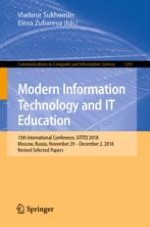This book constitutes the refereed proceedings of the 13th International Conference on Modern Information Technology and IT Education, held in Moscow, Russia, in November-December 2018.
The 30 full papers and 1 short papers were carefully reviewed and selected from 164 submissions. The papers are organized according to the following topics: IT-education: methodology, methodological support; e-learning and IT in education; educational resources and best practices of IT-education; research and development in the field of new IT and their applications; scientific software in education and science; school education in computer science and ICT; economic informatics.
